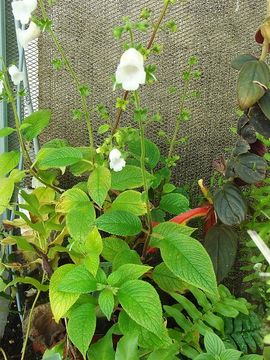
Amaranthaceae is a family of flowering plants commonly known as the amaranth family, in reference to its type genus Amaranthus. It includes the former goosefoot family Chenopodiaceae and contains about 165 genera and 2,040 species, making it the most species-rich lineage within its parent order, Caryophyllales.

The Salsoloideae are a subfamily of the Amaranthaceae, formerly in family Chenopodiaceae.

Halogeton is a plant genus of the family Amaranthaceae. The genus name, Halogeton, derives from the Greek words for "salt" and for "neighbor."

Salsola kali is the restored botanical name for a species of flowering plants in the amaranth family. It is native to the Northern African and European Atlantic coasts to the Mediterranean. It is an annual plant which grows primarily in the temperate biome.

Suaeda is a genus of plants also known as seepweeds and sea-blites. Most species are confined to saline or alkaline soil habitats, such as coastal salt-flats and tidal wetlands. Many species have thick, succulent leaves, a characteristic seen in various plant genera that thrive in salty habitats.

Salsola is a genus of the subfamily Salsoloideae in the family Amaranthaceae. The genus sensu stricto is distributed in Australia, central and southwestern Asia, North Africa, and the Mediterranean. Common names of various members of this genus and related genera are saltwort and tumbleweed or roly-poly. The genus name Salsola is from the Latin salsus, meaning 'salty'.

Kali paulsenii is a species of flowering plant in the amaranth family known by the common name barbwire Russian thistle. It is native to Eurasia and it is present in the American southwest as an introduced species and sometimes a weed in sandy, disturbed habitat types. It is an annual herb forming a brambly clump of intricately branched, prostrate to erect stems growing up to a meter long. The reddish stems are lined with yellow-green, thready, fleshy, or needlelike, spine-tipped leaves a few millimeters to three centimeters long. The inflorescence is an interrupted series of flowers, with one flower per leaf axil. The flower is surrounded by a disclike array of wide, winged sepals which are whitish at the tips and pinkish at the bases.

Soda stocksii is a shrub species of the family Amaranthaceae.

The Suaedoideae are a subfamily of plants in the family Amaranthaceae.

Kali was a genus of plants in the subfamily Salsoloideae in the family Amaranthaceae, that has now been subsumed into the genus Salsola.

Bienertia is a flowering plant genus that currently is classified in the family Amaranthaceae s.l.. For long time, the genus was considered to consist only of one species, Bienertia cycloptera, but in 2005 and 2012, two new species have been separated.
Caroxylon imbricatum, synonym Salsola imbricata, is a small species of shrub in the family Amaranthaceae. It grows in deserts and arid regions of north Africa, the Arabian Peninsula and southwestern Asia.

Caroxylon vermiculatum, commonly known as Mediterranean saltwort, is a perennial plant in the family Amaranthaceae. It has many synonyms, including Salsola vermiculata and Nitrosalsola vermiculata. It is native to arid and semi-arid regions of the Middle East, North Africa and southern Europe where it is used as a fodder plant for livestock.

Caroxylon aphyllum is a small species of shrub in the family Amaranthaceae.

Caroxylon is a genus of shrubby flowering plants in the family Amaranthaceae, found in drier areas of the Old World, including southern Africa, Madagascar, northern Africa, Mediterranean islands of Europe, the Canary Islands, Socotra, Ukraine, Russia, western Asia, Central Asia, India, western and northern China, and Mongolia.
Salsola melitensis is an endemic vascular plant of the Maltese archipelago. Its generic name is derived from the Latin word “salsus” which means salty, attributing to the salt tolerant nature of the species within this genus. The genus name was published in 1753 in the Species Plantarum composed by Carl Linnaeus but was reclassified again by Akhani et al. in 2007.

Gloxiniopsis is a genus of flowering plants belonging to the family Gesneriaceae.
Kaviria is a genus of flowering plants belonging to the family Amaranthaceae.

Pyankovia is a genus of flowering plants belonging to the family Amaranthaceae.
Turania is a genus of flowering plants in the amaranth family, Amaranthaceae. It includes four species native to Central Asia, ranging from Iran and Afghanistan to Xinjiang and Kazakhstan.














